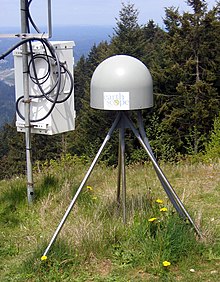139:
44:. PBO construction (an NSF MREFC) took place from October 2003 through September 2008. Phase 1 of operations and maintenance concluded in September 2013. Phase 2 of operations ended in September 2018, along with the end of the EarthScope project. In October 2018, PBO was assimilated into a broader Network of the Americas (NOTA), along with networks in Mexico (
75:
The PBO GPS network included 1100 stations extending from the
Aleutian Islands south to Baja and eastward across the continental United States. During the construction phase, 891 permanent and continuously operating GPS stations were installed, and another 209 existing stations were integrated (PBO
146:
Data from the PBO was, and NOTA data continue to be, transmitted to the GAGE Facility, operated by EarthScope
Consortium, to the data center where it is collected, archived and distributed. These data sets continue to be freely and openly available to the public, with equal access provided for all
59:
PBO precisely measured Earth deformation resulting from the constant motion of the
Pacific and North American tectonic plates in the western United States. These Earth movements can be very small and incremental and not felt by people, or they can be very large and sudden, such as those that occur
147:
users. PBO data includes the raw data collected from each instrument, quality-checked data in formats commonly used by PBO's various user communities, and processed data such as calibrated time series, velocity fields, and error estimates.
60:
during earthquakes and volcanic eruptions. The high-precision instrumentation of the PBO enabled detection of motions to a sub-centimeter level. PBO measured Earth deformation through a network of instrumentation including: high precision
36:
Facility. EarthScope was an earth science program that explored the 4-dimensional structure of the North
American Continent. EarthScope (and PBO) was a 15-year project (2003-2018) funded by the
53:
297:
17:
263:
81:
330:
135:; the backbone cluster was at 100–200 km intervals across the United States to provide complete spatial coverage.
76:
Nucleus stations) into the network. Geodetic imaging data was transmitted, often in realtime, from a wide network of
37:
261:
262:
Williams, M.L., K.M. Fische r, J.T. Freymuelle r, B. Tikoff, A.M. T réhu; et al. (February 2010).
77:
61:
335:
120:
104:
272:
265:
Unlocking the
Secrets of the North American Continent: An EarthScope Science Plan for 2010-2020
150:
Some scientific questions that addressed by the EarthScope project and the PBO data include:
8:
128:
124:
80:
stations, augmented by seismometers, strainmeters and tiltmeters, complemented by InSAR (
291:
112:
208:
142:
An EarthScope GPS sensor, a component of the Plate
Boundary Observatory (PBO) system.
132:
96:
95:
The GPS stations were categorized into clusters. The transform cluster was near the
194:
116:
183:
179:
324:
89:
64:(GPS) and Global Navigation Satellite System (GNSS) receivers, strainmeters,
155:
65:
138:
100:
33:
165:
69:
45:
204:
generated? How does it travel from the mantle to reach the surface?
190:
172:
49:
108:
229:
201:
85:
54:
Geodetic
Facility for the Advancement of Geosciences (GAGE)
41:
178:What influences the location of features such as
161:Are there recognizable precursors to earthquakes?
322:
314:(Washington D.C., National Academy Press, 2001).
249:Plate Boundary Observatory: The first five years
168:influence the motions that are happening today?
193:events or related to deeper processes in the
56:. GAGE is operated by EarthScope Consortium.
296:: CS1 maint: multiple names: authors list (
137:
123:region; the volcanic cluster was in the
82:interferometric synthetic aperture radar
32:(PBO) was the geodetic component of the
312:Review of EarthScope Integrated Science
14:
323:
246:
154:How does accumulated strain lead to
119:); the extension cluster was in the
103:; the subduction cluster was in the
24:
72:, and other geodetic instruments.
25:
347:
304:
255:
240:
222:
164:How does the evolution of the
30:The Plate Boundary Observatory
18:Plate Boundary Observatory PBO
13:
1:
215:
207:What are the precursors to a
189:Is it inherited from earlier
88:(light-activated radar), and
271:. p. 78. Archived from
7:
310:National Research Council,
38:National Science Foundation
10:
352:
40:(NSF) in conjunction with
331:Global Positioning System
62:Global Positioning System
105:Cascadia subduction zone
52:), as part of the NSF's
143:
107:(northern California,
141:
48:) and the Caribbean (
175:structures at depth?
129:Long Valley caldera
125:Yellowstone caldera
144:
209:volcanic eruption
133:Cascade volcanoes
97:San Andreas Fault
16:(Redirected from
343:
315:
308:
302:
301:
295:
287:
285:
283:
278:on 14 April 2015
277:
270:
259:
253:
252:
244:
238:
237:
226:
171:What happens to
117:British Columbia
21:
351:
350:
346:
345:
344:
342:
341:
340:
336:Plate tectonics
321:
320:
319:
318:
309:
305:
289:
288:
281:
279:
275:
268:
260:
256:
247:UNAVCO (2009).
245:
241:
228:
227:
223:
218:
184:mountain ranges
121:Basin and Range
115:, and southern
23:
22:
15:
12:
11:
5:
349:
339:
338:
333:
317:
316:
303:
254:
239:
220:
219:
217:
214:
213:
212:
205:
198:
187:
176:
169:
162:
159:
9:
6:
4:
3:
2:
348:
337:
334:
332:
329:
328:
326:
313:
307:
299:
293:
274:
267:
266:
258:
251:. p. 10.
250:
243:
235:
231:
225:
221:
210:
206:
203:
199:
196:
192:
188:
185:
181:
177:
174:
170:
167:
163:
160:
157:
153:
152:
151:
148:
140:
136:
134:
130:
126:
122:
118:
114:
110:
106:
102:
98:
93:
91:
90:geochronology
87:
83:
79:
73:
71:
67:
63:
57:
55:
51:
47:
43:
39:
35:
31:
27:
19:
311:
306:
280:. Retrieved
273:the original
264:
257:
248:
242:
233:
230:"EarthScope"
224:
149:
145:
94:
74:
66:seismometers
58:
29:
28:
26:
156:earthquakes
325:Categories
234:EarthScope
216:References
131:, and the
113:Washington
101:California
70:tiltmeters
34:EarthScope
292:cite book
166:continent
46:TLALOCNet
191:tectonic
173:geologic
282:9 April
200:How is
50:COCONet
195:mantle
180:faults
127:, the
109:Oregon
276:(PDF)
269:(PDF)
202:magma
86:LiDAR
298:link
284:2015
182:and
42:NASA
99:in
92:.
84:),
78:GPS
327::
294:}}
290:{{
232:.
111:,
68:,
300:)
286:.
236:.
211:?
197:?
186:?
158:?
20:)
Text is available under the Creative Commons Attribution-ShareAlike License. Additional terms may apply.
